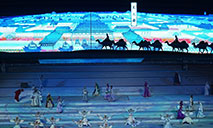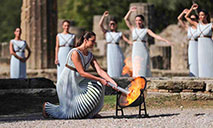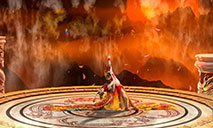After solar conjunction, China's Mars rover Zhurong continues adventures
BEIJING, Oct. 25 (Xinhua) -- China's first Mars rover Zhurong, which lost contact with Earth for about a month during the solar conjunction, has sent back a signal from a distance of 400 million km stating that it is in a normal condition.
During the solar conjunction, when Mars and Earth move to either side of the Sun and the three are almost perfectly aligned, the solar electromagnetic radiation increases, disrupting and even jamming the communications between the Mars probes and Earth.
ADVENTUROUS ROVER
The design team cared about Zhurong just like people care about a child who has gone away to summer camp, said Jin Shengyi, the deputy chief designer for teleoperation subsystem of Zhurong from the China Academy of Space Technology (CAST).
"We cared about Zhurong, but we have full confidence in it. When we designed it, we took all possible situations into account," said Jin.
Chen Baichao, the chief designer of Zhurong from CAST, said it would be very difficult to keep a spacecraft in a normal condition for such a long time without ground control. But Zhurong has autonomous systems designed to cope with the solar conjunction and winter on Mars.
According to Chen, the rover has traveled more than 1,000 meters since it landed on Mars at the southern part of Utopia Planitia in May 2021. After the solar conjunction, it will head south to find mud volcanoes, which scientists are interested in, located about 10 km away.
Before Zhurong, five American rovers had landed on Mars. Although a latecomer, Zhurong has a unique innovation: it is the first Mars rover equipped with active suspension.
The idea of active suspension came from Chen, who has a background in ground vehicle engineering.
"Mars has a complex terrain with soft sand and rocks all over it, and we are worried that the rover will sink in the sand. Active suspension allows the rover to crawl out of a trap like a worm. It can also walk sideways like a crab, flexibly avoid obstacles and climb slopes at steep angles," said Chen.
With a height of 1.85 meters and a weight of 240 kg, Zhurong can travel at a speed of 200 meters per hour on Mars, which is similar to that of China's lunar rover Yutu-2. But Zhurong has traveled more than 1,000 meters in over three months, faster than Yutu-2 has done in two years.
"Zhurong, with a good memory, is more capable and more reliable. It can endure both cold and hot environments, so it can travel faster and farther," said Chen.
Originally, ground control made a plan for Zhurong to conduct environment perception, scientific detection and movement tasks over a three-day cycle. However, this was later changed to a one-day cycle. Zhurong has so far remained stable and executed the orders well.
In the eyes of Jia Yang, deputy chief designer of the Tianwen-1 probe from CAST, the rover is like an adventurous boy who is working diligently to get more results before the Martian winter.
Mars is far away from Earth, and the one-way communication between the rover and ground control takes about 20 minutes. So ground control is not able to implement timely operation of the rover.
The designers gave Zhurong the ability to deal with complex problems autonomously. As a smart rover, it only communicates with Earth once or twice a day. It can plan its own path and avoid obstacles, and can decide when to sleep and wake up, depending on environmental changes.
"Communication between the rover and the orbiter starts when the orbiter flies over the rover, so timing is very important. If space particles cause malfunctions of the rover's onboard computer, it will disturb the rover's time system," said Jia.
"We designed a set of algorithms for Zhurong to calculate time based on the trajectory of sunlight, just like survival in the wild."
SURVIVING ON MARS
Strong winds, rocky surfaces and sand storms -- the environment on Mars is much harsher than that on Earth. However, the designers have optimized the rover's ability to survive in the Martian environment.
According to Jia, the accumulation of Martian dust on the solar wings of the rover can affect the efficiency of power generation. "Due to the special design of the solar wings, the dust falling on them will be easily blown away by the wind, just like drops of water blown from the leaves of a lotus," he said.
Chen Baichao said the initial design of Zhurong featured only two solar wings. The designers wanted larger solar panels and they brought out more than 10 solutions, such as bat-like folding wings and flexible solar wings.
Chen was inspired by the wings of blue morpho butterfly, and decided to design the rover's wings like those of a butterfly, unfolding in two stages.
The designers also installed a heat-collecting device on the top of Zhurong, the first of its kind used in a rover, to keep it warm at night.
The device uses a chemical called n-undecane to store heat energy. During the day, the substance absorbs heat and melts, and when the temperature drops at night, it releases heat in the process of solidification to keep the rover warm.
The light on Mars is another challenge. "The light is unstable on Mars, and there is scattered light. We had no idea how much it would contribute to solar-wing power generation," said Chen.
After a year of experimenting and research, the designers established a theoretical model of solar-power generation on Mars. Now they can infer weather conditions on the planet from this model.
CHINESE FOOTPRINTS
Zhurong has left Chinese footprints in the sand of the red planet. Inscribed on the surface of the rover's rear wheels is the Chinese character "Zhong" -- the first character of the word Zhongguo, which means China. The character "Zhong" is imprinted in the two ruts made by the rover as it travels across the surface of Mars.
"We carved Zhong on the wheel surfaces not just for symbolic purposes, but also for technical reasons. We can measure the slip ratio of the rover by the distance between the Zhong characters," said Jia.
The circumference of the wheel is one meter. If the distance between the Zhong characters is one meter, it indicates that the rover is running normally. If the distance is obviously shorter, it means that the rover is skidding and may sink in the sand.
"When we designed the rover, we did a lot of brainstorming to learn from every way of thinking. We want not only a powerful rover that can work normally on the surface of Mars, but also a beautiful rover that can represent the highest level of Chinese space engineering."
After the rover was completed, the designers wanted to use Chinese cultural elements to make it more beautiful. The artist Su Dabao created a pattern featuring the Chinese character "fire" using a combination of Chinese calligraphy and seal cutting. The decorative pattern was installed on the "head" of the rover before it was launched.
"Zhurong gives us a Martian view of our solar system, a deeper understanding of the universe, and has inspired us to ponder the old questions: Who am I? Where do I come from? Where will I go?" said Jia.
Photos
Related Stories
Copyright © 2021 People's Daily Online. All Rights Reserved.










